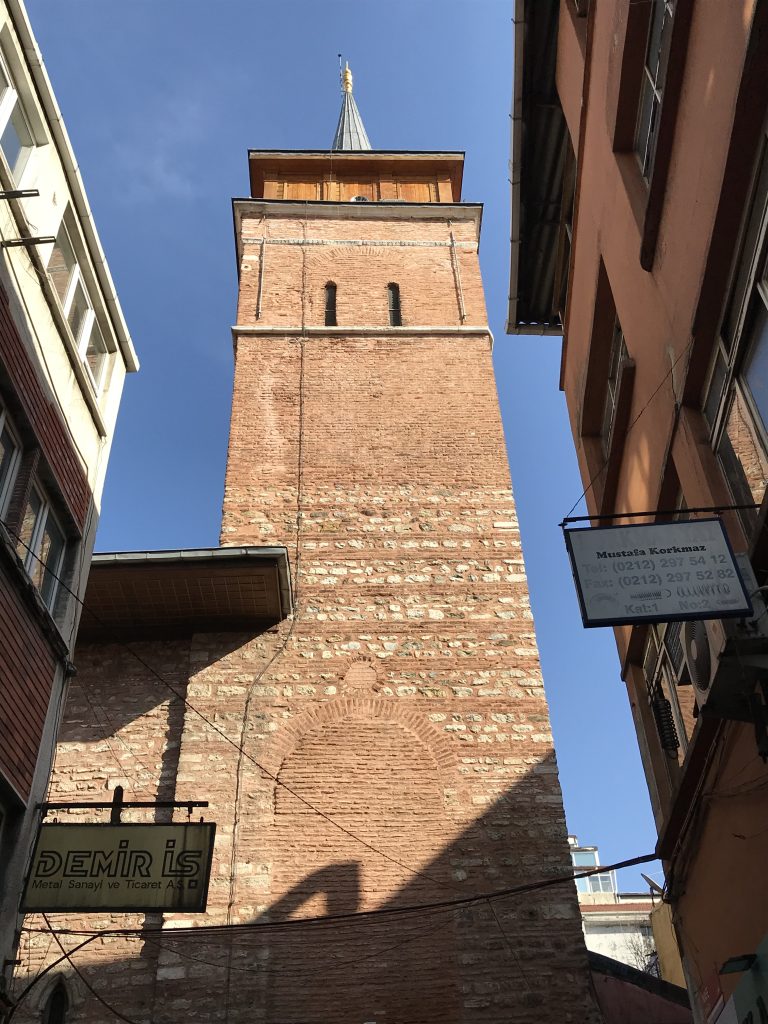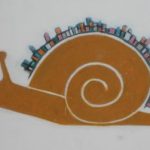“Thursday Market”
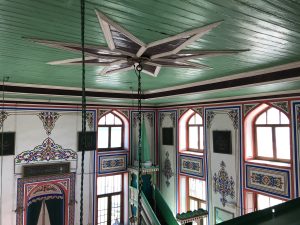
Strictly speaking the name of a short street linking busy Tersane Caddesi to Voyvoda (Bankalar) Caddesi, Perşembe Pazarı is also the name generally given to the area of Karaköy that lies immediately west of the Galata Bridge as it starts to run alongside the Golden Horn. For most people this is a part of town to be whipped through in a bus while gazing out of the windows in amazement at the endless string of hardware shops. There are, however, a few unexpected architectural gems lurking unvisited amid the workaday stores.
Around Perşembe Pazarı
If you strike west from the Galata Bridge following Tersane Caddesi you will quickly pass the lower station of the Tünel funicular whose lobby contains some mementoes and information about its history.
Continuing west you will come on the sea side of the road to the Rüstem Paşa (Kurşunlu) Hanı, an unexpected early Ottoman han built by Sinan between 1544 and 1550 to provide accommodation for visiting traders, stabling for their animals and space to store their goods. Today it’s still very much in use although in a fragile state of repair. A Genoese cathedral dedicated to St Michael is believed to have stood on the same spot although there’s no longer any trace of it. To find the han you will need to turn down one of the side turnings heading towards the water.  Rüstem Paşa Han
Rüstem Paşa Han
A little further along the road on the same side the Fatih Hanı (Bedesten) is easier to spot especially since its roof boasts an impressive nine domes. There’s no absolute certainty about its date although it is thought to have been built in the 15th-century reign of Sultan Mehmed II, which would make it one of the oldest surviving Ottoman buildings in the city.
If you keep walking along the road you will arrive in Azapkapı beside the Atatürk Köprüsü (Atatürk Bridge, 1940).
Perşembe Pazarı itself leads off the far side of the road opposite the Rüstem Paşa Hanı and is interesting primarily for the soot-blackened brick-built houses that stand on either side of it. Architecturally, they look as if they must be Byzantine but in fact they appear to be proof that the “Byzantine” style continued virtually unchanged into Ottoman times.
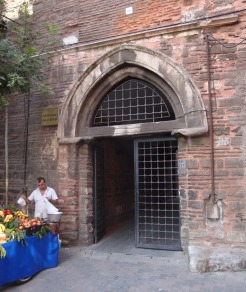 Typically Gothic entrance to Arap CamiIf you turn left into Galata Mahkamesi Sokak and keep walking you will come eventually to the enormous Arap Cami (Arab Mosque), whose square tower and rectangular walls make it plain that it actually started life as a church. It was apparently built by Dominican Friars in 1323 and seems to have been mainly used by the Genoese community to judge from the around 120 gravestones found during excavations. They in turn seem to have built on a site already occupied by a Byzantine church of St Paul. In 1475 the church was given to the Moors who had been expelled from Spain in 1492, hence its name, the Arab Mosque. The friars then moved uphill towards a new site near the Galata Tower.
Typically Gothic entrance to Arap CamiIf you turn left into Galata Mahkamesi Sokak and keep walking you will come eventually to the enormous Arap Cami (Arab Mosque), whose square tower and rectangular walls make it plain that it actually started life as a church. It was apparently built by Dominican Friars in 1323 and seems to have been mainly used by the Genoese community to judge from the around 120 gravestones found during excavations. They in turn seem to have built on a site already occupied by a Byzantine church of St Paul. In 1475 the church was given to the Moors who had been expelled from Spain in 1492, hence its name, the Arab Mosque. The friars then moved uphill towards a new site near the Galata Tower.
The Marmara earthquake of 1999 caused some of the plasterwork of the vaults to fall away exposing traces of what appear to be 14th-century frescoes of the Life of Christ and various saints, showing the strong local influence of Byzantine art even in what was a Latin context.
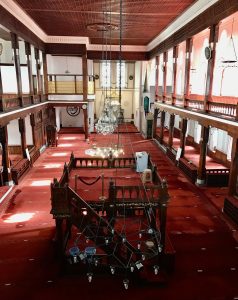
Also in the back streets here you will find the busy Bereketzade Medresesi Cami, dating back to 1705 and named after its founder, Bereketzade Mehmet Efendi. In a sign of gentrification extending to this side of the Galata Bridge, the Mahkeme Lokantası could hardly be more of the minute.
It’s also possible to approach Perşember Pazarı by walking down beside Galata Bridge and past the Karaköy fish market, which is a more attractive route than along the busy but more obvious main road.
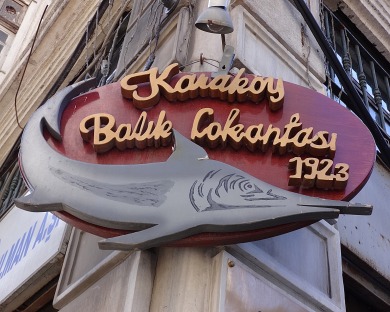
Eating
There are tables set up in the fish market where you can eat fish bought such minutes earlier provided you don’t mind the absence of alcohol. Nearby is Akın Balık (Tel: 0212-244 9776), a simple yet pleasant fish restaurant with outside tables, some of them with a water view as well as alcohol.
Karaköy Balık Lokantası In business since the founding of the Republic, this historic fish restaurant in the back streets running down to the water beside the Kurşunlu Hanı is well known for its balık çorbası (fish soup) which can be savoured alongside a splendid view. Kürekciler Kapısı Sokak No.45. Tel: 0212-215 4151
Mahkeme Lokantası
Garnering great reviews for its dining, the Mahkeme Lokantası is housed in a lovely old warehouse with exposed-brick walls. The menu is heavy on fish but offers other choices too. Don’t be fooled by the “lokanta” name – this is a fine-dining restaurant with fine-dining prices. Mahkeme Sokak No 2/A. Tel: 0212-255 3255
Transport info
Coming from İstiklal Caddesi the best bet to get to this area is either to walk downhill along Voyvoda Caddesi or take the Tünel funicular to Karaköy. There are also plenty of buses from Taksim or Eminönü. Or you can take the tram from Sultanahmet to Karaköy and then walk.
Nearby areas
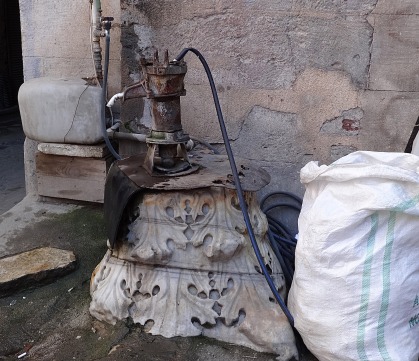 Old Byzantine capital casually reused as a fountain inside the Kurşunlu Hanı
Old Byzantine capital casually reused as a fountain inside the Kurşunlu Hanı
